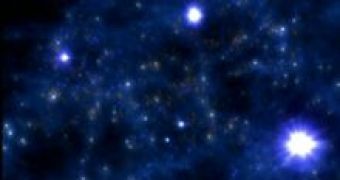Scientists using NASA's Spitzer Space Telescope say they have detected light that may be from the earliest objects in the universe.
If confirmed, the observation provides a glimpse of an era more than 13 billion years ago when, after the fading embers of the theorized Big Bang gave way to millions of years of pervasive darkness, the universe came alive.
This light could be from the very first stars or perhaps from hot gas falling into the first black holes. The science team, based at NASA Goddard Space Flight Center in Greenbelt, Md., describes the observation as seeing the glow of a distant city at night from an airplane. The light is too distant and feeble to resolve individual objects.
Scientists theorize that space, time and matter originated 13.7 billion years ago in a Big Bang. Another 200 million years would pass before the era of first starlight. A 10-hour observation by Spitzer's infrared array camera in the constellation Draco captured a diffuse glow of infrared light, lower in energy than optical light and invisible to us.
The Goddard team says that this glow is likely from Population III stars, a hypothesized class of stars thought to have formed before all others. (Population I and II stars, named by order of their discovery, comprise the familiar types of stars we see at night.)
Theorists say the first stars were likely over a hundred times more massive than Earth's sun and extremely hot, bright, and short-lived, each one burning for only a few million years. The ultraviolet light that Population III stars emitted would be redshifted, or stretched to lower energies, by the universe's expansion. That light should now be detectable in the infrared.

 14 DAY TRIAL //
14 DAY TRIAL //